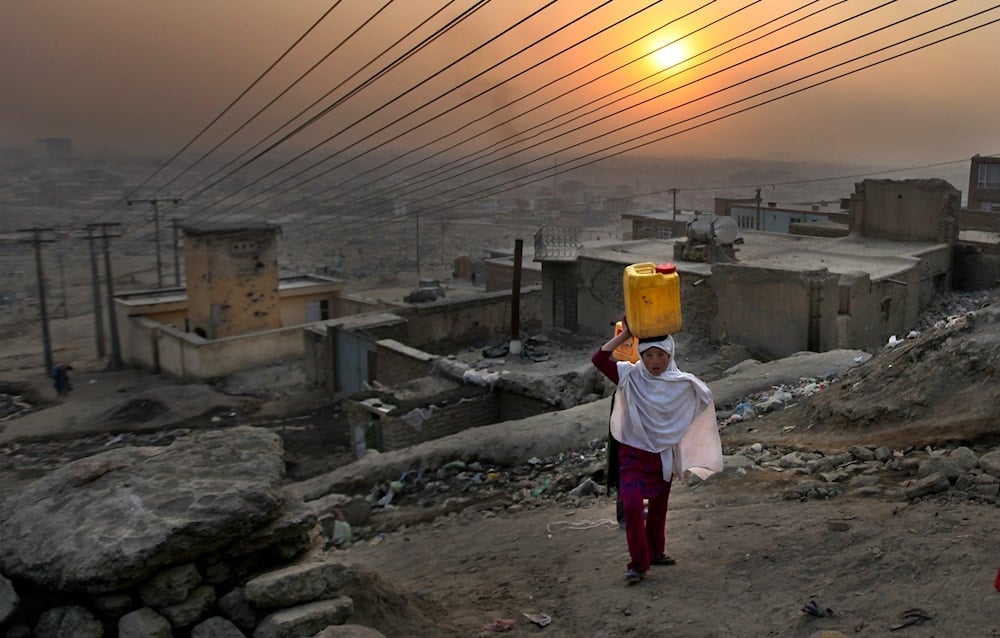Kabul faces total water collapse by 2030
Experts warn Kabul could become the first modern city to run out of water by 2030 due to aquifer depletion, unregulated extraction, and stalled international aid.
-

An Afghan girl carries water in a plastic container as she ascends a slope on the way towards her house in Kabul, Afghanistan, on December 27, 2010. (AP Photo/Altaf Qadri)
Kabul may become the first modern city to completely run out of water, experts have warned. A new report by Mercy Corps reveals that water levels in the Afghan capital’s aquifers have dropped by up to 30 meters over the past decade, driven by rapid urbanization and climate change.
Almost half of the city’s boreholes, the primary source of drinking water, have dried out. Water extraction currently exceeds the natural recharge rate by 44 million cubic meters annually. If this trend continues, all of Kabul’s aquifers could be depleted as early as 2030, threatening the survival of the city’s estimated seven million residents.
“There should be a committed effort to document this better and to draw international attention to the need to address the crisis,” said Dayne Curry, Mercy Corps’ country director for Afghanistan. “No water means people leave their communities. Ignoring this crisis will only result in more migration and more hardship.”
Water scarcity deepens daily struggle for Kabul’s residents
Water contamination adds another layer of danger. Up to 80% of Kabul’s groundwater is considered unsafe, polluted by sewage, salinity, and arsenic. For many residents, accessing water is a daily struggle. Some households spend up to 30% of their income on water, while more than two-thirds incur water-related debt.
“Afghanistan is facing a lot of problems, but this water scarcity is one of the hardest,” said Nazifa, a teacher living in the Khair Khana neighborhood. "Adequate, good-quality, well water just doesn’t exist."
Private companies have capitalized on the crisis by digging new wells and selling groundwater at inflated prices. "We used to pay 500 afghanis every 10 days. Now, that same amount of water costs us 1,000," Nazifa added. "It’s only getting worse."
Read next: Hydropolitics and Taliban's water policy; Goals and Prospects
Kabul’s population has grown sevenfold since 2001, severely increasing water demand. A lack of centralized water governance and decades of under-regulation have made matters worse.
In early 2025, the UN’s Office for the Coordination of Humanitarian Affairs announced it had received only $8.4 million of the $264 million needed for water and sanitation programming in Afghanistan. Meanwhile, more than $3 billion in international funding remains frozen since the Taliban’s return to power in 2021. Recent US cuts to more than 80% of its USAID funding have exacerbated the crisis.
“Everything is so aid-dependent,” Curry noted. “We can throw millions at short-term fixes, but the need will persist without long-term investment, and foreign governments are falling short due to political dynamics.”
Panjshir river pipeline offers hope, if funded
One proposed solution is the Panjshir River pipeline, which could supply potable water to 2 million Kabul residents. Design phases were completed in late 2024, but the $170 million project is still awaiting budget approval. The Afghan government is seeking investors to make up the funding shortfall.
"We don’t have time to sit around waiting for budgets," said Dr. Najibullah Sadid, a senior water resource researcher and member of the Afghan Water and Environment Professionals Network. "We are caught in a storm from which there will be no return if we don’t act immediately."
Despite the hardship, residents like Nazifa say they are willing to contribute to sustainable water solutions.
She said, “Water is a human right and a natural resource of Afghanistan. It is not a political issue,” adding, “My heart bleeds when I look at the flowers and fruit trees in the garden, all drying up. But what can we do? We are currently living in a military state, we can’t go to the government to report the issue.”
Dr. Sadid echoed the urgency, "People are choosing between food and water. But they are still willing to invest what little they have in solutions. We just need to start somewhere."

 4 Min Read
4 Min Read








